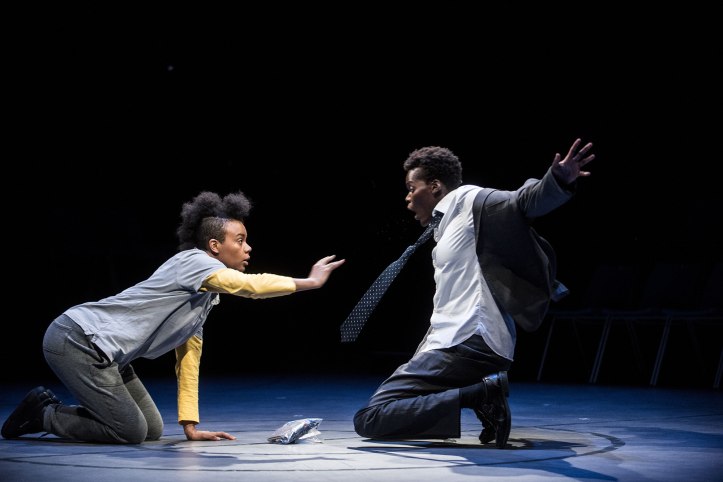
By Ross
Walking into the theatre at St. Ann’s Warehouse to see The Tempest has a déjà vue kind of feeling. Returning to visit a familiar place to see some recognizable faces doing some spectacular Shakespeare once again. Like a yearly pilgrimage. And what a happy return it is. Donmar Warehouse has brought back to Brooklyn the all female acting troop with Harriet Walter at the helm, as strong and self-assured as she was in the previous two Shakespearean transfers, Henry IV and Julius Caesar. The set up is the same: a female prison institutional basketball court with the inmates, marched in through the lobby, playing all the roles of another Shakespeare play. Surrounded by fencing and guards, it feels like we have returned for visitation (kudos to the design team – Designer: Chloe Lamford; Theatrical Environment Designer: Bunny Christie; Lighting Designer: James Farncombe). We see some familiar faces, and maybe a few new ‘inmates’, but we really have come to reconnect with Walter. And what a joy it is, to visit with this powerhouse again.

The beginning of The Tempest, as chaperoned magnificently by director Phyllida Lloyd, is intense, original, and layered. Walter tells us her prisoner/character story. It’s a compelling and powerful confession, instantly engaging. As a political activist/rebel, she took part in an illegal act for the sake of the ’cause’ which resulted in a number of deaths. When arrested, her plea was based on political solidarity, and she was given a hefty life sentence. This story is a strong base statement on behalf of the character, the theatrical concept, and a layer of depth to the overall arc. Her admission places this drama (and the two other previous Shakespearian plays) into an arena of politics and power dynamics, steeped in aggression, revenge, and guilt. She is Prospero, the magician and sorcerer; banished to a remote island/prison; sent by a corrupt system that worked against him/her. Powerless but with great strength. Manipulator who can conjure the spirits to do his will. Struggling with rage and revenge against the powers that be. All of these completely in the realm of what Shakespeare wrote about, but here in this prison, Walter’s inmate carries the same burdens (based on a real life American political idealist and prisoner Judy Clark). All the inmates as performed by this stellar ensemble, find themselves confined in an environment that strips them of all the stereotypical feminine shackles, rendering them ‘free’ to all the traits, characteristics, and power dynamics that exist in the human and male dominated world. Inside a women’s prison, dressed in prisoner (and guard) uniforms, the characters become androgynous, transformed, where all female or male personas are self created and presented intentionally when needed. The parallels to Shakespeare are profound, and setting this play within those walls only shines more light on the roles we all play in order to survive. Three times might not be the charm in this creation, but it still packs a punch, regardless how many of these female driven plays you’ve seen.

Visiting this prison once again, we find the same band of characters. Jade Anouka is one of those familiar faces that can’t be forgotten. She wondrously played Hotspur in Henry IV, and now, equally magnificent, but magically unique, she plays Ariel with ease and charm. Same with the hilarious Sophia Stanton who played the fool, Falstaff, but now takes on the equally foolish and very devilish Caliban. The scenes with the two drunken servants, Stefano (Jackie Clune) and Trinculo (Karen Dunbar), also both alumni from Henry IV, are some of the funniest bits in the play, all doing fantastic and detailed work. This list of familiarity could go on and on, but ultimately what’s most important is that all of these women shine in their portraits of both an inmate, and their Shakespearean counterpart. In some ways, the familiar set up diminishes the ultimate power that is attached to the first time viewing. I was transfixed by all the layers that existed when I first saw Henry IV (click to read my review), and here at The Tempest, I was intrigued but not blown away, which I must admit was a bit disappointing. Many of the themes and ideas seemed repeated. That’s not to say it didn’t inspire deep inspection and fascination, but some of the thrill and excitement was dampened due to the sameness of the exercise.

Re-reading my review last year of Henry IV, most of the thoughts were too similar to the ones that rushed through my mind the night I saw The Tempest. The powerful degrading march of the inmates through the lobby. The intensity of the play within the walls of a prison. The guards role in bringing back oppression and reminding us all that these women are not free, nor are they powerful, regardless of their taking on these powerful dominant roles. It’s true that much of the same ideology resonate here as they did last year, but there is a bit more to add on at the end. Henry IV ended in the rupturing of the event, when aggression took over, and destroyed the context and delivery of the play. Here, I got the sense we were saying good-bye to Walker and the Trilogy with love and care. She was to remain behind on this ‘island’, still a prisoner, when the others are set free, and return to a life outside of that cell/island. Prospero ends the story as he wanted. But traditionally, he is left alone asking the audience to be set free. Walter’s inmate reclines on her bed, while it appears the other inmates are being released. They say good-bye, enriched by her strength and the play’s power. Light has been released because of these women and the roles they played. We bid Walker a fond farewell alongside the inmates. And thank her for the journey and the enlightenment.

[…] The Tempest: A Fond Farewell to a Political Prisoner […]
LikeLike
[…] it out, and check out a few of my other recent reviews: The Tempest […]
LikeLike
[…] https://frontmezzjunkies.com/2017/01/28/the-tempest/ […]
LikeLike
[…] Ann’s Warehouse One Brooklyn/off off show Streetcar Named Desire Beauty Queen of Leenane The Tempest Escaped […]
LikeLike
[…] Doll’s House, Part 2 Amy Ryan, Love, Love, Love, Roundabout Theatre Company Harriet Walter, The Tempest, St. Ann’s Warehouse Outstanding Actor in a Musical Nick Blaemire, Tick, […]
LikeLike
[…] prison production of this tragedy performed by a band of tattooed men, much like the female driven Tempest, Henry IV, and Julius Caesar that was performed at St. Ann’s Warehouse last year. But instead of […]
LikeLike
[…] flash and fire by Phyllida Lloyd (Donmar/St. Ann’s all-female Shakespeare trilogy, including The Tempest and Henry IV), with dynamite choreography by Anthony Van Laast (Mamma Mia! worldwide), Tina, the […]
LikeLike
[…] out, just happens to be with a woman, played to perfection by Jade Anouka (Donmar/St Ann’s The Tempest). What will father have to say about […]
LikeLike